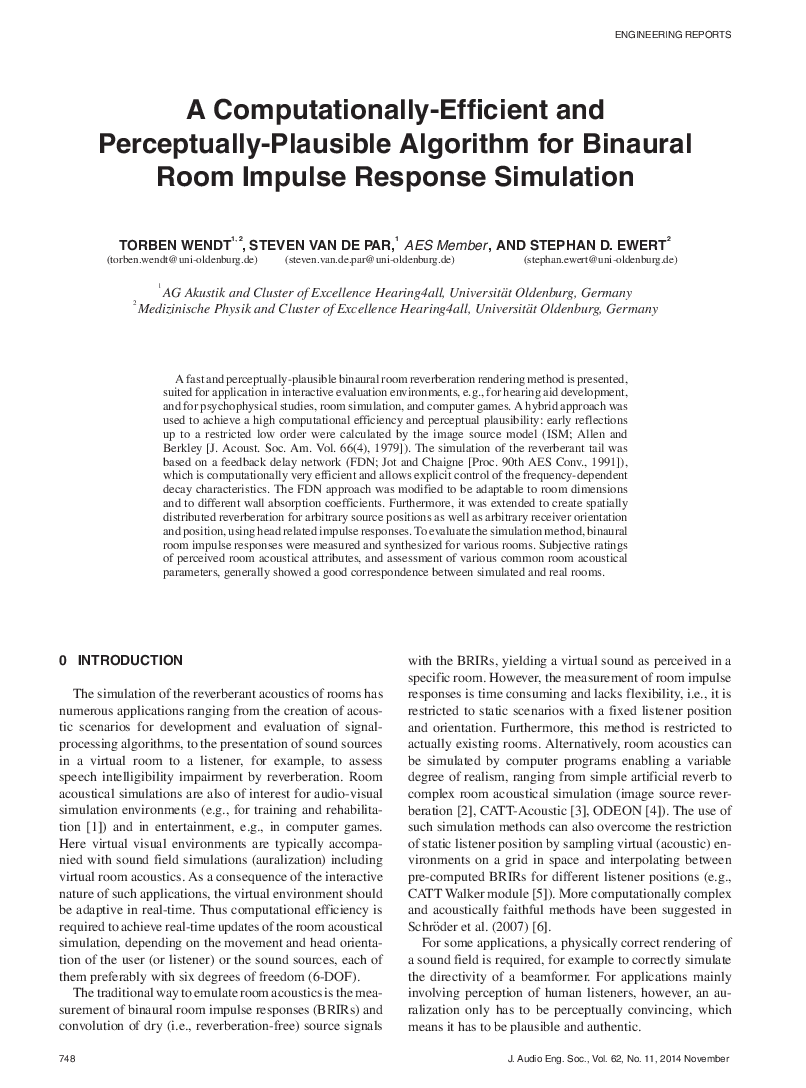Home / Publications / E-library page
You are currently logged in as an
Institutional Subscriber.
If you would like to logout,
please click on the button below.
Home / Publications / E-library page
Only AES members and Institutional Journal Subscribers can download
Simulating the reverberation of rooms has numerous applications that range from evaluating acoustic scenarios in the development of signal processing algorithms to the exploration of speech intelligibility in virtual rooms with movable sources. A hybrid approach was created to simulate room acoustics, achieving high computational efficiency and perceptual plausibility: early reflections were calculated using the image source model (ISM) and the reverberant tail used a feedback delay network (FDN). The FDN approach was modified to be adaptable to various room dimensions and wall absorption coefficients. Using head-related impulse responses, the authors extended it to create spatially-distributed reverberation for arbitrary source and receiver positions. Subjective ratings of the perceived room attributes and the assessment of various common parameters showed a good correspondence between simulated and real rooms.
Author (s): Wendt, Torben; van de Par, Steven; Ewert, Stephan D.
Affiliation:
AG Akustik and Cluster of Excellence Hearing4all, Universität Oldenburg, Germany; Medizinische Physik and Cluster of Excellence Hearing4all, Universität Oldenburg, Germany
(See document for exact affiliation information.)
Publication Date:
2014-11-06
Import into BibTeX
Permalink: https://aes2.org/publications/elibrary-page/?id=17550
(809KB)
Click to purchase paper as a non-member or login as an AES member. If your company or school subscribes to the E-Library then switch to the institutional version. If you are not an AES member Join the AES. If you need to check your member status, login to the Member Portal.

Wendt, Torben; van de Par, Steven; Ewert, Stephan D.; 2014; A Computationally-Efficient and Perceptually-Plausible Algorithm for Binaural Room Impulse Response Simulation [PDF]; AG Akustik and Cluster of Excellence Hearing4all, Universität Oldenburg, Germany; Medizinische Physik and Cluster of Excellence Hearing4all, Universität Oldenburg, Germany; Paper ; Available from: https://aes2.org/publications/elibrary-page/?id=17550
Wendt, Torben; van de Par, Steven; Ewert, Stephan D.; A Computationally-Efficient and Perceptually-Plausible Algorithm for Binaural Room Impulse Response Simulation [PDF]; AG Akustik and Cluster of Excellence Hearing4all, Universität Oldenburg, Germany; Medizinische Physik and Cluster of Excellence Hearing4all, Universität Oldenburg, Germany; Paper ; 2014 Available: https://aes2.org/publications/elibrary-page/?id=17550
@article{wendt2014a,
author={wendt torben and van de par steven and ewert stephan d.},
journal={journal of the audio engineering society},
title={a computationally-efficient and perceptually-plausible algorithm for binaural room impulse response simulation},
year={2014},
volume={62},
issue={11},
pages={748-766},
month={november},}
TY – paper
TI – A Computationally-Efficient and Perceptually-Plausible Algorithm for Binaural Room Impulse Response Simulation
SP – 748 EP – 766
AU – Wendt, Torben
AU – van de Par, Steven
AU – Ewert, Stephan D.
PY – 2014
JO – Journal of the Audio Engineering Society
VO – 62
IS – 11
Y1 – November 2014